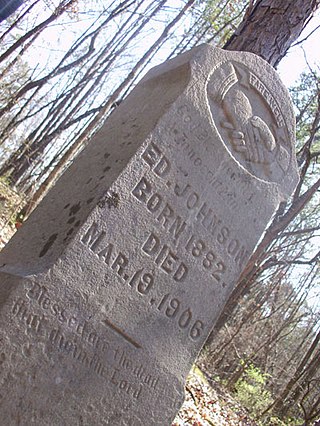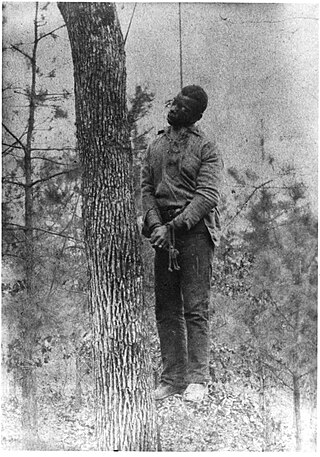Related Research Articles

The Scottsboro Boys were nine African American male teenagers accused in Alabama of raping two white women in 1931. The landmark set of legal cases from this incident dealt with racism and the right to a fair trial. The cases included a lynch mob before the suspects had been indicted, all-white juries, rushed trials, and disruptive mobs. It is commonly cited as an example of a legal injustice in the United States legal system.
Mack Charles Parker was an African-American victim of lynching in the United States. He had been accused of raping a pregnant white woman in northern Pearl River County, Mississippi. Three days before he was to stand trial, Parker was kidnapped from his jail cell in the Pearl River County Courthouse by a mob, beaten and shot. His body was found in the Pearl River, 20 miles west of Poplarville, 10 days later. Following an investigation by the Federal Bureau of Investigation, the men who killed him were released. Despite confessions, no one was ever indicted for the killing. Historian Howard Smead called the killing the "last classic lynching in America."
David C. Hennessy was a police chief of New Orleans. As a young detective, he made headlines in 1881 when he captured a notorious Italian criminal, Giuseppe Esposito. In 1888, he was promoted to superintendent and chief of police. While in office he made a number of improvements to the force, and was well known and respected in the New Orleans community.

Jesse Washington was a seventeen-year-old African American farmhand who was lynched in the county seat of Waco, Texas, on May 15, 1916, in what became a well-known example of lynching. Washington was convicted of raping and murdering Lucy Fryer, the wife of his white employer in rural Robinson, Texas. He was chained by his neck and dragged out of the county court by observers. He was then paraded through the street, all while being stabbed and beaten, before being held down and castrated. He was then lynched in front of Waco's city hall.
United States v. Shipp, 203 U.S. 563 (1906), were rulings of the Supreme Court of the United States with regard to Sheriff Joseph F. Shipp and five others of Chattanooga, Tennessee, having "in effect aided and abetted" the lynching of Ed Johnson. They were held in contempt of court and sentenced to imprisonment. It remains the only Supreme Court criminal trial in history.
Crime in Omaha, Nebraska has varied widely, ranging from Omaha's early years as a frontier town with typically widespread gambling and prostitution, to civic expectation of higher standards as the city grew, and contemporary concerns about violent crimes related to gangs and dysfunctions of persistent unemployment, poverty and lack of education among some residents.

Willie McGee was an African American man from Laurel, Mississippi, who was sentenced to death in 1945 and executed on Tuesday, May 8, 1951, after being controversially convicted for the rape of a white woman on November 2, 1945. McGee's legal case became a cause célèbre that attracted worldwide attention, as it was roundly decried as a miscarriage of justice in the Jim Crow south.

On March 19, 1906, Ed Johnson, a young African American man, was murdered by a lynch mob in his home town of Chattanooga, Tennessee. He had been sentenced to death for the rape of Nevada Taylor, but Justice John Marshall Harlan of the United States Supreme Court had issued a stay of execution. To prevent delay or avoidance of execution, a mob broke into the jail where Johnson was held, and abducted and lynched him from the Walnut Street Bridge.
Ell Persons was a black man who was lynched on 22 May 1917, after he was accused of having raped and decapitated a 15-year-old white girl, Antoinette Rappel, in Memphis, Tennessee, United States. He was arrested and was awaiting trial when he was captured by a lynch party, who burned him alive and scattered his remains around town, throwing his head at a group of African Americans. A large crowd attended his lynching, which had the atmosphere of a carnival. No one was charged as a result of the lynching, which was described as one of the most vicious in American history, but it did play a part in the foundation of the Memphis chapter of the NAACP.
Roy Mitchell was an African-American man from Waco, Texas who was convicted of six murders and executed on July 30, 1923. His arrest, trial, conviction, and execution are considered an example of continued bigotry in the Texas judicial system of the 1920s, but also of reforms aimed at curbing mob violence and public lynching. Mitchell was the last Texan to be executed in public and is often described as the last to be legally hanged before the introduction of the electric chair.
On Tuesday, November 12, 1914, John Evans, a black man, was lynched in St. Petersburg, Florida, United States, by a mob of 1,500 white men, women and children. Evans was accused of the murder of Edward Sherman, a white real estate developer, and the attack of Sherman's wife, Mary. After word of the attack spread, and Mary Sherman claimed her attackers were "two negroes," a citywide search ensued. Suspicions immediately led to John Evans. Two days after the murder, a posse consisting of some of the city's most prominent and well-respected members stormed the St. Petersburg jail, threw a noose around Evans' neck and marched him to his death. He was never given a fair trial. Evans was hanged from a light post on the corner of Ninth Street South and Second Avenue. At first, he kept himself alive by wrapping his legs around the light pole. An unidentified white woman in a nearby automobile ended his struggle with a single bullet. Though the shot was fatal, the rest of the crowd began shooting at Evans' dangling body until their ammunition was depleted.
Columbus Lee Harkins (1864 – July, 30, 1920) was an American veterinary surgeon, serial child rapist, and suspected mass murderer.
Samuel "Mingo Jack" Johnson was an African American man falsely accused of rape. He was brutally beaten and hanged by a mob of white men in Eatontown, New Jersey.

Amos Miller was a 23-year-old African-American man who was lynched from the balcony of the Williamson County Courthouse in Franklin, Tennessee, on August 10, 1888.

The lynching of Paul Reed and Will Cato occurred in Statesboro, Georgia on August 16, 1904. Five members of a white farm family, the Hodges, had been murdered and their house burned to hide the crime. Paul Reed and Will Cato, who were African-American, were tried and convicted for the murders. Despite militia having been brought in from Savannah to protect them, the two men were taken by a mob from the courthouse immediately after their trials, chained to a tree stump, and burned. In the immediate aftermath, four more African-Americans were shot, three of them dying, and others were flogged.

James Harvey and Joe Jordan were two African-American men who were lynched on July 1, 1922, in Liberty County, Georgia, United States. They were seized by a mob of about 50 people and hanged while being transported by police from Wayne County to a jail in Savannah. Investigations by the NAACP showed that the police involved were complicit in their abduction by the mob. Twenty-two men were later indicted for the lynching, with four convicted.

George Meadows was an African American man who was lynched on January 15, 1889, in Jefferson County, Alabama, United States.
The hanging of Charles Blackman occurred in Ellaville, Georgia, on January 25, 1889. Stonewall Tondee, a white man, had been murdered on September 5, 1885. Charles Blackman, an African-American man, was tried and convicted for the murder in three trials by all-white, "gentleman" juries. The Georgia Supreme Court twice granted Blackman a new trial, but he was convicted and sentenced to hang a third time in September 1888. Blackman was twice granted respite by Georgia Governor John Brown Gordon after the third trial, which delayed Blackman’s execution by three months. Blackman maintained his innocence until his public execution and insisted that he was never given an impartial trial. 5,000 people from across South Georgia travelled to Ellaville, a town of a few hundreds, to witness the hanging. Telegraph wires were cut to ensure that messages from Governor Gordon and other state officials would not be transmitted and interfere with the hanging.
The lynching of George Hughes, which led to what is called the Sherman Riot, took place in Sherman, Texas, in 1930. An African-American man accused of rape and who was tried in court died on May 9 when the Grayson County Courthouse was set on fire by a White mob, who subsequently burned and looted local Black-owned businesses. Martial law was declared on May 10, but by that time many of Sherman's Black-owned businesses had been burnt to the ground. Thirty-nine people were arrested, eight of whom were charged, and later, a grand jury indicted 14 men, none for lynching. By October 1931, one man received a short prison term for arson and inciting a riot. The outbreak of violence was followed by two more lynchings in Texas, one in Oklahoma, and several lynching attempts.

William Andrews was an African American laborer who was lynched by a white mob in Princess Anne, Maryland on June 9, 1897. Andrews, then 17, was tried, convicted, and hanged all in one day after being accused of assaulting Mrs. Benjamin T. Kelley.
References
- ↑ Baker, Bruce E. (September 1, 2005). "Lynch Law Reversed: The Rape of Lula Sherman, the Lynching of Manse Waldrop, and the Debate Over Lynching in the 1880s". American Nineteenth Century History. 6 (3): 273–293. doi:10.1080/14664650500380993. S2CID 144435565 – via CrossRef.
- ↑ Hill, Karlos K. (January 2010). "Black Vigilantism: The Rise and Decline of African American Lynch Mob Activity in the Mississippi and Arkansas Deltas, 1883-1923". The Journal of African American History. 95 (1): 26–43. doi:10.5323/JAFRIAMERHIST.95.1.0026. S2CID 140461204.
- ↑ Orr, Michaella. "Call My Name Resistance Tour: Cato Sherman - A Story About a Father Who Lost His Daughter and Gained Justice for Her". Upcountry Historical.